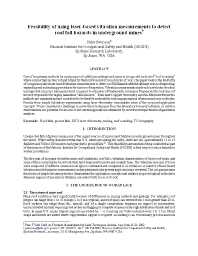Mining Publication: Feasibility of Using Laser-Based Vibration Measurements to Detect Roof Fall Hazards in Underground Mines
Original creation date: June 2002
One of the primary methods for analyzing roof stability in underground mines is the age-old method of "roof sounding" where a miner taps on the roof and listens for the hollow sound of loose blocks of rock. This paper looks at the feasibility of using noncontact laser-based vibration measurements to detect roof fall hazards with the ultimate vision of improving, expanding and automating procedures for mine roof inspection. Vibration measurements made on loose blocks of rock in underground mines are summarized and compared to estimates of fundamental resonance frequencies for rock slabs of the size responsible for highly hazardous "skin failures." Both laser Doppler vibrometry and full-field interferometric methods are examined and are considered to be feasible methods for detecting anomalous vibrations in loose roof rocks. Results from simple laboratory experiments using laser vibrometry demonstrate some of the proposed application concepts. While considered a challenge to move these techniques from the laboratory to heavy industrial or outdoor environments, the potential for success in the current application is enhanced by the reduced requirements of qualitative analyses.
Authors: PL Swanson
Conference Paper - June 2002
NIOSHTIC2 Number: 20029463
Fifth International Conference on Vibration Measurements by Laser Techniques: Advances and Applications, June 18 - 21, 2002, Ancona, Italy. EP Tomasini, ed., Bellingham, WA: The International Society for Optical Engineering, 4827:541-552
See Also
- Diagnosing and Controlling Moisture-Sensitive Roof in Coal Mines
- Effects of Far-Field Shearing Deformation on Fracturing Around an Underground Opening
- The Introduction of Roof Bolting to U.S. Underground Coal Mines (1948-1960): A Cautionary Tale
- Optimizing Secondary Roof Support with the NIOSH Support Technology Optimization Program (STOP)
- Origin of Mining-Induced Fractures Through Macroscale Distortion
- Preventing Injuries Caused by Unrecognized Stone Mine Roof Beam Failures With a Pro-Active Roof Control Plan
- Report on Early Strength Performance of Modern Day Weak Rock Mass Shotcrete Mixes
- Roof and Rib Fall Incident Trends: a 10-Year Profile
- Technique to Assess Hazards in Underground Stone Mines: the Roof Fall Risk Index (RFRI)
- Water and Slurry Bulkheads in Underground Coal Mines: Design, Monitoring, and Safety Concerns
- Page last reviewed: 9/21/2012
- Page last updated: 9/21/2012
- Content source: National Institute for Occupational Safety and Health, Mining Program


 ShareCompartir
ShareCompartir
